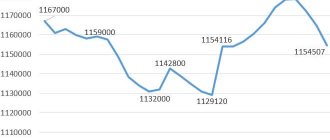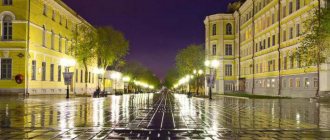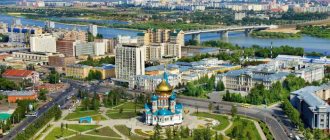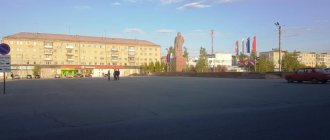The population of Nizhny Novgorod and the Nizhny Novgorod region, like the population of any other region of the country, can be classified and described according to a number of factors. This includes numbers, density, national and age composition, as well as many other indicators. Each of them is important for determining the demographic situation in the region. Let's find out the composition of the population of the Nizhny Novgorod region according to various indicators.
Population
First of all, you should find out the population of the Nizhny Novgorod region. After all, most other demographic data are calculated based on this indicator. So, the population of the Nizhny Novgorod region today is 3260.3 thousand people, which is the eleventh largest figure among 85 regions of Russia. In percentage terms, the number of residents of the Novgorod region is 2.22% of the population of the Russian Federation.
Next we will look at other indicators of the region's demographics.
Population dynamics
It should be noted that until 1990, the population of the Nizhny Novgorod region grew numerically, but in the subsequent period it began to fall. Thus, if in 1897 the population of the region was 1584.8 thousand people, then by 1970 it more than doubled and amounted to 3682.5 thousand people. Twenty years later, this figure was already equal to 3780.3 thousand people, but, as mentioned above, today it has decreased to 3260 thousand people.
The year 1990 can be characterized as a demographic breaking point. It is characteristic that the population of Nizhny Novgorod and the Nizhny Novgorod region began to decrease precisely when the collapse of the USSR took place and the country was experiencing political and economic changes. This fact could not but affect demographics. Moreover, the greatest rate of population decline was observed from 1991 to 1995. During this time, the natural decline of residents increased by 3.4 times. The highest mortality rate was observed in 2003 (69.9 thousand people), and the lowest birth rate was in 1999 (27.0 thousand people).
Since 2006, there has been a constant increase in the birth rate. Until 2010, the birth rate increased by 0.2 times, while the mortality rate fell by 0.15 times.
The region is currently experiencing migration growth, which is constantly increasing. This fact suggests that, in comparison with other regions of Russia, the standard of living in the Nizhny Novgorod region is at a fairly acceptable level.
Currently, the population of the Nizhny Novgorod region continues to decrease numerically, but natural decline is also constantly decreasing in comparison with previous years. If this trend continues, we will soon again be able to observe a numerical increase in the population of the region.
One district of the Nizhny Novgorod region has increased its population in three years
Rosstat published in May fresh data on the permanent population in the Nizhny Novgorod region (as of January 1, 2022). Comparing these data with the figures for 2022, one can note the population increase in one district of the region – Kstovsky. Over three years, the increase was more than 3% (in absolute figures, 4,061 people). At the same time, a decrease was recorded in the regional center. This is explained by the commissioning of apartment buildings in the Afoninsky village council (residential complex "Krasnaya Polyana"), where from 2018 to 2022 the population increased by 1,424 people, as well as mass low-rise buildings in the Bolsheelninsky village council (in 2018 there were 10,979 people here, in 2022 year - 11882, per year increase of 903 inhabitants).
Noteworthy are the record-breaking losses of the Bogorodsky district - immediately by almost 15% (minus 10,106 people). However, nothing extreme happened: in 2022, the Novinsky Village Council, by the will of the authorities, was transferred to the Nizhny Novgorod urban district. Despite the change in administrative boundaries, the population of the regional center over three years increased by only 4,303 residents (0.34%).
Another city in the Nizhny Novgorod region increased its population - Sarov (by 0.7%). The rest are only losing residents, including such industrial centers as Vyksa (minus 0.65%), Pavlovo (minus 1.65%), Zavolzhye (minus 1.68%).
The greatest losses were in the Krasnooktyabrsky district - minus almost 5.5% of the population. The Gaginsky district is close to this indicator - minus 5.1%.
In general, the population of the Nizhny Novgorod region decreased by 11,677 people in just one year (if on January 1, 2022 there were 3,214,623 Nizhny Novgorod residents, then on January 1, 2022 - 3,202,946). This is more than the number of residents in the Sharangsky district.
| County/city/district | 2018 | 2019 | 2020 | Loss/growth over three years | % |
| g.o. Nizhny Novgorod | 1267464 | 1261823 | 1271767 | 4303 | 0,34 |
| g.o. Sarov | 95388 | 95469 | 96052 | 664 | 0,7 |
| g.o. Bor | 120926 | 119383 | 118156 | — 2770 | — 2,29 |
| g.o. Vyksa | 82280 | 81654 | 81745 | — 535 | — 0,65 |
| g.o. Vorotynsky | 18262 | 18025 | 17666 | — 596 | — 3,26 |
| g.o. Dzerzhinsk | 240719 | 239419 | 238841 | — 1878 | — 0,78 |
| g.o. Kulebaki | 48173 | 47619 | 47165 | -1008 | — 2,09 |
| g.o. Navashinsky | 22234 | 21944 | 21772 | — 462 | — 2,08 |
| g.o. Pervomaisk | 18332 | 18125 | 17990 | — 342 | — 1,87 |
| g.o. Perevozsky | 15776 | 15620 | 15455 | — 321 | — 2,51 |
| g.o. Semenovsky | 47399 | 46946 | 46662 | — 737 | — 1,55 |
| g.o. Sokolsky | 13019 | 12834 | 12719 | — 300 | — 2,3 |
| g.o. Chkalovsk | 19986 | 19695 | 19517 | -469 | — 2,35 |
| g.o. Shakhunya | 35851 | 35285 | 34874 | — 977 | — 2,73 |
| Ardatovsky district | 23166 | 22869 | 22522 | — 644 | — 2,78 |
| Arzamas district | 41534 | 40890 | 40248 | — 1286 | — 3,1 |
| g.o. Arzamas | 104140 | 103930 | 103979 | — 161 | — 0,15 |
| Balakhninsky district | 76266 | 75851 | 75698 | — 568 | — 0,74 |
| Balakhna | 49126 | 48710 | 48520 | — 606 | — 1,23 |
| Bolsheboldinsky district | 11051 | 10874 | 10732 | — 319 | — 2,89 |
| Bogorodsky district | 69463 | 70549 | 59357 | — 10106 | — 14,6 |
| Bogorodsk | 34240 | 33931 | 33756 | — 484 | — 1,41 |
| Bolshemurashkinsky district | 9538 | 9491 | 9353 | — 185 | — 1,94 |
| Buturlinsky district | 13513 | 13387 | 13261 | — 252 | — 1,86 |
| Vadsky district | 14276 | 13978 | 13922 | -354 | — 2,48 |
| Varnavinsky district | 12229 | 12027 | 11841 | — 388 | — 3,17 |
| Vachsky district | 17562 | 17350 | 17017 | — 545 | — 3,1 |
| Vetluzhsky district | 14670 | 14488 | 14236 | — 434 | — 2,96 |
| Vetluga | 8455 | 8459 | 8336 | — 119 | — 1,41 |
| Voznesensky district | 15292 | 15072 | 14851 | — 441 | — 2,88 |
| Vorotynsky district | 18262 | 18025 | 17666 | — 596 | — 3,26 |
| Voskresensky district | 19735 | 19459 | 19300 | — 435 | — 2,2 |
| Volodarsky district | 58186 | 57954 | 57962 | — 224 | — 0,38 |
| Volodarsk | 9972 | 9907 | 9898 | — 74 | — 0,74 |
| Gaginsky district | 11051 | 10781 | 10487 | — 564 | — 5,1 |
| Gorodets district | 87208 | 86059 | 85620 | — 1588 | — 1,82 |
| Gorodets | 30188 | 29854 | 29712 | — 476 | — 1,58 |
| Zavolzhye | 38230 | 37758 | 37588 | — 642 | — 1,68 |
| Dalnekonstantinovsky district | 20880 | 20676 | 20352 | — 528 | -2,53 |
| Diveyevo district | 15498 | 15160 | 14959 | — 539 | — 3,48 |
| Knyaginsky district | 11554 | 11350 | 11168 | — 386 | — 3,34 |
| Knyaginino | 6804 | 6629 | 6536 | — 268 | — 3,94 |
| Koverninsky district | 18543 | 18297 | 18176 | — 367 | — 1,98 |
| Krasnooktyabrsky district | 9764 | 9431 | 9228 | — 536 | — 5,5 |
| Krasnobakovsky district | 21608 | 21435 | 21258 | — 350 | — 1,62 |
| Kstovsky district | 121877 | 124071 | 125938 | 4061 | 3,33 |
| Kstovo | 67874 | 67439 | 67797 | — 77 | — 0,11 |
| Lukoyanovsky district | 29582 | 29078 | 28593 | — 989 | — 3,34 |
| Lukoyanov | 14104 | 13913 | 13763 | — 341 | — 2,42 |
| Lyskovsky district | 38229 | 37849 | 37407 | — 822 | — 2,15 |
| Lyskovo | 21321 | 21176 | 21063 | — 258 | — 1,21 |
| Pavlovsky district | 94355 | 93162 | 92394 | — 1961 | — 2,08 |
| Pavlovo | 57630 | 57028 | 56680 | — 950 | — 1,65 |
| Vorsma | 10491 | 10331 | 10253 | — 238 | — 2,27 |
| Gorbatov | 1934 | 1896 | 1844 | — 90 | — 4,65 |
| Pilninsky district | 19540 | 19293 | 19033 | — 507 | — 2,59 |
| Pochinkovsky district | 28213 | 27928 | 27616 | — 597 | — 2,12 |
| Sergachsky district | 28256 | 27769 | 27489 | — 767 | — 2,71 |
| Sergach | 20269 | 19997 | 19939 | — 330 | — 1,63 |
| Sechenovsky district | 14195 | 13978 | 13768 | — 427 | — 3,01 |
| Sosnovsky district | 17924 | 17763 | 17641 | — 283 | — 1,58 |
| Spassky district | 9486 | 9225 | 9029 | — 457 | — 4,82 |
| Tonkin district | 7809 | 7640 | 7538 | — 271 | — 3,47 |
| Tonshaevsky district | 18730 | 18572 | 18274 | — 456 | — 2,43 |
| Urensky district | 28512 | 28204 | 28055 | — 457 | — 1,6 |
| Uren | 12309 | 12205 | 12251 | — 58 | — 0,47 |
| Sharangsky district | 11708 | 11608 | 11434 | — 274 | — 2,34 |
| Shatkovsky district | 23800 | 23284 | 22829 | — 971 | — 4,08 |
Support our media with any amount feasible for you - once, or by subscribing using the online cash register. By becoming a KozaPress subscriber, you will support the stable operation of the publication by making a personal contribution to the protection of freedom of speech.
18+
Population density
Density can be calculated by knowing the number of people in the Nizhny Novgorod region and the area of the territory occupied by them.
The area of the region is 76,624 square meters. km. Thus, by simple calculations it can be established that the average population density of the Nizhny Novgorod region is 42.6 people/sq. km. This is the 23rd result out of 85 regions of the country. If we do not take into account the population density in regions whose main territory is cities, then the Nizhny Novgorod region will be in 20th place. For comparison: in the most populated region of the country (Moscow), the population density is 164.9 people/sq. km, and in the most deserted region (Chukchi Autonomous Okrug) – 0.1 people/sq. km.
So the Nizhny Novgorod region looks good in the all-Russian statistics on population density. The area and population of this region are correlated in such a way that the number of people living here is higher than in a significant part of other subjects of the Federation.
Only 32% of Nizhny Novgorod residents have higher education
Right
Among the employed population (over 15 years of age, who at least occasionally receive money for work) in Russia, 34.2% have higher education, 45% have secondary vocational education, 17.2% of Russians have secondary education, 3.4% have basic education (9 grades). %. There are also those who have no education at all - 0.2% of the population. The figures are approximately the same in the Nizhny Novgorod region - 32% of the employed population has a “tower”. The most “educated” city is Moscow, where almost 50% of the residents have higher education.
It is noteworthy that in no region the percentage of people with higher education fell below 20.
Urbanization level
A very important demographic indicator is the level of urbanization. It will help to understand how the population of the Nizhny Novgorod region is distributed between cities and villages.
The number of inhabitants of the cities of this Volga region today is about 2590.8 thousand inhabitants. At the same time, 669.5 thousand people live in villages. The population of the cities of the Nizhny Novgorod region is almost four times higher than the rural population.
Thus, the percentage of population between urban and rural areas is 79.5 and 20.5%, respectively. This suggests that the Nizhny Novgorod region is a fairly urbanized region. Of course, in comparison with the Murmansk region or the Khanty-Mansi Autonomous Okrug, where the share of urban residents exceeds 90%, the indicator of the Volga region will not seem so high, but in comparison with the Republic of Ingushetia (41.3%), the Republic of Chechnya (34.8 %) and even more so with the Altai Republic (29.2%) it looks quite convincing.
The Nizhny Novgorod region is in a demographic hole
On the eve of International Statistics Day (celebrated on October 20), Nizhny Novgorodstat published information about the demographic situation in the Nizhny Novgorod region. Let's say right away, dear readers: the numbers will not please you.
According to the head of Nizhny Novgorodstat, Galina Polyakova (remember, she is a specialist with a specialized education and has been in the profession for almost 40 years), “statistics is present in almost all spheres of human life, government decisions, commercial steps and even public activities begin with the collection and analysis of statistical data " Let's see what these data are for our region in the section usually designated by statisticians as “Population”.
Predicted attrition
So, as of January 1, 2022, the population of the Nizhny Novgorod region was 3,202,946 people. Men are traditionally in the minority in Russia, there are 1,456,349 of them, with the share of people under working age being 19.4%, those of working age being 63.8%, and pensioners being 16.8%. At the beginning of the year, there were 1,746,597 women living in the region, of which 15.3% were below working age, 48.5% were of working age, and 36.2% were older than working age, that is, more than twice as many elderly representatives of the middle sex.
The average age of Nizhny Novgorod residents was 41.6 years, despite the fact that in terms of life expectancy, ladies give a noticeable head start to gentlemen: over 44 thousand Nizhny Novgorod and region residents are aged 85 years or more.
Support the publication
- Join the CLAN
Or
“This is generally a global trend; women in most countries live longer,” says sociologist Oleg Tsvetkov. – Among them, adherents of bad habits are less common, they are less inclined to engage in extreme sports, and work in hazardous industries. And if they work, then, according to Rostrud, they comply with safety requirements more carefully than the stronger sex. Finally, in our country women are not drafted into the army.
Therefore, it is not surprising that such an indicator as “life expectancy” is higher for women - 77.8 years versus 66.5 for men.
But this is the prospect for those born in 2019. Now let's take a closer look at the current statistics. During January–August 2022, 18,187 babies were born in the region, and this is 1,234 fewer newborns than in the same period last year. Even sadder is the increase in mortality: 33,499 people versus 31,370 in 2019. The natural population decline in the region amounted to 15,312 people, which is approximately 3.5 thousand worse than last year’s figure.
Family life for our fellow countrymen is not going well. Over the eight months of this year, 10,368 marriages were registered, 2,858 less than last year. And this is with 7514 divorces. It is not difficult to calculate that more than every second family union breaks up.
“The economic situation in the region this year has sharply worsened both due to sanctions pressure on the largest city-forming enterprises, such as the automobile plant, and due to the CoViD-19 pandemic,” explains Vasily Samykin, Candidate of Economic Sciences. – Massive lockdowns have “taken one gate” of many businesses in areas such as catering, transport, the hospitality industry, fitness, and various offline educational and training courses. Economic troubles traditionally and in any country influence the marital behavioral model of the population: planned marriages and the birth of children are postponed until better times. I am afraid that by the end of the year we will not see an increase in the number of induced abortions, as was the case in the second half of 1998, after the August default.
Environmental influence
“The steady excess of the population mortality rate since the early 1990s predetermined the process of depopulation, which clearly indicates the crisis development of the demographic situation in the last decade and a half in the Russian Federation as a whole and in particular in the Nizhny Novgorod region,” emphasizes Doctor of Medical Sciences Vladislav Mirzonov. “All these factors, combined with a tense socio-economic situation, significantly reduce the reproductive potential of society, its ability to reproduce.”
According to Dr. Mirzonov, the low reproduction rates of the population of the Nizhny Novgorod region are largely related to the peculiarities of its age structure, the formation of which was seriously influenced by the steady, up to the 1990s, migration outflow of Nizhny Novgorod residents, primarily villagers, to other regions of the country. Unfortunately, this factor is still active today: young people are actively leaving for the nearby capital.
“In the dynamics of mortality in the region’s population, three periods are quite clearly distinguished, two of which had a negative and one a positive development trend,” continues Vladislav Mirzonov. – The first period, 1989–1994, is characterized by a deep political and socio-economic transformation of society, a change in social value priorities: negative processes in the demographic development of the country, including in the Nizhny Novgorod region, sharply accelerated. The second period, 1995–1998, was characterized by a certain adaptation of the population to new conditions: the number of deaths noticeably decreased both overall and among the working-age population.
Doctor Mirzonov fully agrees with economist Samykin in assessing the consequences of the impact of economic crises on the demographic indicators of the region.
“The crisis events of August 1998 had a profound negative impact on demographic processes,” says Vladislav Mirzonov. – This year the region had the lowest birth rate in the entire history of statistical observations: 7.3 per thousand population, which is two times lower than in 1987. The pre-crisis birth rate in the region was reached only in 2001. When characterizing the mortality rates of the population during this period, it is necessary to especially emphasize the exceptional stability of negative processes: the steady increase in the absolute number of deaths and the mortality rate persists throughout the entire period.
In addition to the “new old” threat - a drop in the birth rate due to the economic crisis - the second problem characteristic of Nizhny has not gone away: internal migration of the population outside the region.
“In recent decades, in the Nizhny Novgorod region there has been an outflow of the rural population to the regional center and beyond,” states Candidate of Geographical Sciences, Associate Professor Anna Pukhova. – As a result of internal migration processes, the proportion of young people living in rural areas is decreasing, which contributes to the accelerated aging of the rural population, increased mortality and a decrease in the labor potential of the countryside. The crisis in agricultural production and the decline of small towns and urban settlements is the main cause of negative migration and demographic processes. The effectiveness of the economy and government policy largely depends on the share of youth in the total labor force. Unfortunately, this category of the population, at best, will remain unchanged in the near future, while the proportion of people of retirement age will increase.
I wish I could get out
Experts predicted the current demographic hole in which the region is firmly entrenched long ago. Exactly seven years ago, in October 2013, the head of Nizhny Novgorod Statistics, Galina Polyakova, introduced the public to the demographic forecast plan for the period until 2030. The authors of the document even then about and by the beginning of 2031 in comparison with 2012 it will fall by almost 7%. The forecast dynamics of the birth rate, which had a downward trend, also seemed disappointing, which is confirmed by today's data.
The demographic statistics of the capitals of the Volga Federal District are also sad. Within the Volga Federal District this summer, our ambitious neighbor, Kazan, surpassed us in terms of population, albeit only slightly so far.
“There are socio-economic ways to increase the population of a territory, they require a lot of time and resources,” explains Vasily Samykin. – And there are also administrative and political ones, fast and inexpensive. It is possible to increase the number of city residents by annexing adjacent rural municipalities. We remember that on January 1, 2022, the Novinsky Village Council became part of Nizhny Novgorod. This is plus 12 thousand new Nizhny Novgorod residents. At the same time, the administrative game was quite masterly: the New Products were included not in the city, but in the “urban district of Nizhny Novgorod”, that is, people retained almost all the usual benefits on utility tariffs, transport tax and the like. Now there are 17,300 villagers living in the Nizhny Novgorod urban district, these are the villages of the Prioksky, Sovetsky, and Nizhny Novgorod districts. It is enough to introduce these territories into the city with the stroke of a pen at the mayor’s office and – voilà! – The lowest in population again becomes the first in the Volga Federal District.
But all this is nothing more than administrative sleight of hand. While in the region the mortality rate is 1.6 times higher than the birth rate, and when these two graphs are combined, the notorious “Russian demographic cross” is formed, unfortunately, one cannot count on stopping or at least slowing down the depopulation of the Nizhny Novgorod region. In addition, as Associate Professor Pukhova correctly notes, “a reduction in the share of people of working age will hamper economic growth both in Russia as a whole and in the Nizhny Novgorod region.”
Lifespan
One of the indicators that indicate the standard of living of the population is its expected duration. This indicator is sometimes mistakenly called average life expectancy, but this is not entirely true. Life expectancy is a prediction of how long people born in a given year will live on average.
This figure for the Nizhny Novgorod region for 2014 is 69.5 years; 12 months before that it was 69.4 years. It should be noted that life expectancy in this region as a whole has been increasing since 2004, although in some years there has been a slight drop. The minimum life expectancy in the Nizhny Novgorod region was registered in 2003. Then it was 63.6 years.
It should be noted that in 2014 this figure for women was 76 years, and for men – 63.3 years. For comparison: in Russia as a whole, the life expectancy of the population born in 2014 is 70.9 years. At the same time, for men it is 65.3 years, and for women it is 76.5. Thus, the life expectancy of the population in 2014 in the Nizhny Novgorod region was worse than in the country as a whole.
30% of Nizhny Novgorod residents are adherents of a healthy lifestyle
False
Of course, a healthy lifestyle should play a key role in increasing life expectancy. Despite all the popularization of the sport, according to data for 2022, only 9% of Nizhny Novgorod residents are its adherents. According to this indicator, the region lags significantly behind others in the Volga Federal District. For example, in Chuvashia there are 24.7% of “zozhniki”, in the Samara region, Mordovia and Bashkartostan - about 20%. At the same time, in Udmurtia and the Penza region the figure does not exceed 5%.
National composition
Now let's find out the national composition of the region's inhabitants. The population of the Nizhny Novgorod region is quite ethnically diverse. The nationalities that represent the region are quite diverse. But among them the Russians stand out numerically. Currently, their number in the Nizhny Novgorod region is approximately 3110 thousand people, or 93.9% of the population of the entire region. Thus, this nationality has unconditional dominance in this subject of the Federation. This situation has persisted for hundreds of years. It must be said that for the XX-XXI centuries. the percentage of Russians to all residents of the region never fell below 92%.
Among the national minorities inhabiting the Nizhny Novgorod region, Tatars are in first place. This is due to the proximity of the region to the Republic of Tatarstan. The number of Tatars is about 44 thousand people, or 1.33% of the total population. Tatars in terms of number of residents are followed by Mordovians (0.58%), Ukrainians (0.53%), Armenians (0.4%) and Chuvash (0.29%).
Among the population of the Nizhny Novgorod region there are also such exotic nationalities as Koreans and Yezidis, but their number is quite small and does not exceed several thousand people.
About 300 thousand Nizhny Novgorod residents live below the poverty line
Right
In rubles, everything looks, of course, more impressive: the salaries of Nizhny Novgorod residents increased on average from 16 to 32 thousand rubles. By the way, in terms of salaries, the region ranks 20th in Russia and 2nd in the Volga Federal District, slightly inferior to Tatarstan with 34 thousand rubles. The highest salaries are in the northern regions. Moscow is only in 4th place.
It is worth noting that over the past 10 years in the Nizhny Novgorod region the number of people who earn less than the subsistence level has decreased slightly - from 12.3% to 9.5%. But in any case, this is about 300 thousand people. At the same time, those who earn more than 60 thousand rubles per month are also about 10%.
Goods and services have become more expensive (the consumer price index has increased) in the Nizhny Novgorod region over 10 years by an average of 90%. The increase affected products to a greater extent - their cost almost doubled.
Housing prices have not increased so significantly - by 25–30% for housing in the primary market and about 40–45% in the secondary market.
Religious composition
Now let's find out what the population of the Nizhny Novgorod region is like in religious terms.
On the territory of the described subject of the Federation there are quite a few different religious movements. In addition, Nizhny Novgorod is the administrative center of not only the region, but also the Volga Federal District, which, in turn, is the most multi-religious region of the Russian Federation.
The majority of the region's population are Orthodox Christians. Their number currently reaches 76% of all residents of the region. Nizhny Novgorod even has its own metropolis, and the number of parishes in the region reaches 420. In addition, there are fifteen monasteries.
One of the currents of the Orthodox religion is the Old Believers. However, the official church considers this trend sectarian. At the same time, it is the Nizhny Novgorod region that is the cradle of this religious movement. The organizer of his ideology, Archpriest Avvakum, was born here. Therefore, it is natural that it is in this region, in comparison with other subjects of the Federation, that the traditions of the Old Believers remain quite strong. The community of Old Believers is especially large in the Koverninsky district.
Members of other Christian denominations are also present in the region. These are representatives of various Protestant movements: Baptists, Pentecostals, Seventh-day Adventists, Lutherans and other, younger churches. The traditions of Protestantism have been strong in the region since the time of settlement of these places by the Volga Germans. In addition, there is a Catholic parish in Nizhny Novgorod, but it has a rather limited number of parishioners.
There are many Muslims in the Nizhny Novgorod region. There are even more of them than representatives of various Christian movements (naturally, if you do not take into account the Orthodox). This situation is associated with the relatively large number of Tatars and other peoples living in the region, whose national religion is Islam. The Spiritual Administration of Muslims, located in Nizhny Novgorod, is considered the center of Islam in the region.
In addition, there is a Jewish community in the Nizhny Novgorod region. The only synagogue in the region is located in its administrative center - Nizhny Novgorod. At the same time, the total number of Jews in the region is 3.7 thousand people.
There are also residents in the region who profess other religions, but they are not united in communities and do not have official status.
As we can see, the religious diversity in the Nizhny Novgorod region is very diverse.
Questionable leadership. Why is the Nizhny Novgorod region losing population?
For the fifth year in a row, the Nizhny Novgorod region holds the lead in natural population decline. Moreover, the reason is not only the increase in mortality. Nizhny Novgorod residents are getting married less and less often. But even in marriage, many do not risk having children, worrying about their future given high housing prices and low standards of living and medical care. Details are in the FederalPress article.
According to Rosstat, the Nizhny Novgorod region is the leader among the regions of the Russian Federation in terms of natural population decline. The region has recorded an excess of deaths over births for the fifth year. In 2014, this figure was 13.1 thousand people, in 2015 – 10.6 thousand people, in 2016 – 11.4 thousand people, in 2017 – 13.4 thousand people.
According to the latest data, in January-August 2022, the Nizhny Novgorod region also holds the lead in natural population decline - 11.6 thousand people. At the same time, mortality increased by 3.3% compared to the same period in 2022, and the birth rate decreased by 7.2%. However, natural decline, an increase in the number of deaths and a decrease in the number of newborns are characteristic of the entire country. Only the North Caucasus Federal District, which shows natural growth, stands out from the overall picture.
Medicine and ecology
Ecologists explain the reduction in the number of Nizhny Novgorod residents by the poor environmental situation, and doctors by the fact that the population does not like to see doctors, despite the conditions created for normal appointments without queues.
Ecologist Askhat Kayumov notes that in the Nizhny Novgorod region, in recent years, the emission of pollutants into the air both from vehicles and “from the economy” has been increasing, and after this, with a lag of six months to a year, mortality from respiratory diseases is increasing.
More on the topic
In Berezovsky they are looking for a “sweetheart” who set up a landfill on an area of more than a million “squares”
Askhat Kayumov also points to the high incidence of cancer in the Nizhny Novgorod region. “And cancer incidence is external factors. The body itself will not suddenly develop cancer for no reason at all,” explains the ecologist. – This is water quality, air quality, food quality. But environmental factors are among the leading ones.”
The head of the press service of the Nizhny Novgorod Medical Academy, Alexei Nikonov , agrees that there are many hazardous industries in the region, but reminds that, according to WHO, the quality of life expectancy of the population of any country depends 50% on lifestyle, 20% on medical care, and only on 10% - from the environment. In his opinion, no matter how hard doctors and clinics try, one of the main problems is that people do not seek medical help in a timely manner.
“Some people have a mentality in their heads that there are queues, long appointments, and you won’t get to see a doctor. Although now in many clinics there are no longer queues and you can sign up electronically, explains Alexey Nikonov. – Periodic medical examinations and regular medical examinations are required. But you yourself need to try in every possible way to monitor your diet and the optimal regime of physical activity.”
Alexey Nikonov adds that sedentary work has become the norm for most, but in the end it has a bad effect on the cardiovascular system. According to Rosstat, both in Russia and in the Nizhny Novgorod region in particular, the main mortality occurs due to diseases of the circulatory system.
Infant mortality also makes a “contribution” to the increase in mortality. According to Rosstat, the Nizhny Novgorod region, which in recent years has shown a decrease in this indicator, has shown an increase this year. Moreover, according to the Accounts Chamber, an increase in deaths among children under one year of age was noted in nine regions where perinatal centers have opened in recent years. However, the country’s Ministry of Health indicates that it is too early to calculate these data: we must wait for the results of the whole year.
Fewer people are giving birth and more people are leaving
But not only mortality affects population decline. Russians in general and Nizhny Novgorod residents in particular are in no hurry to have children. Timur Khusainov , a teacher at the Department of Social Sciences at the National Research University Higher School of Economics - Nizhny Novgorod, points out a decrease in the number of marriages in the Nizhny Novgorod region: from 7.4 per 1 thousand people in 2022 to 6.7 in 2022, that is, by almost 10%.
“But even in cases where a marriage takes place, not all young families are ready to have a child, much less several,” notes Khusyainov. – In conditions of growing precarization of labor, high housing prices and mortgage rates, not every family is ready to have a child, even just one. Thus, 54% of Russians, according to VTsIOM data for 2022, do not plan to have children in the next few years. Among the factors identified by respondents that influence the decision are the low amount of benefits, insufficient number of educational institutions, low level of medical care and, in general, life, and high prices.”
If we take the same Rosstat data, then at the end of the second quarter of 2018, the cost of housing on the primary market in the Nizhny Novgorod region amounted to 58.4 thousand rubles per sq. m. m, on the secondary – 60.9 thousand rubles per sq. m. m. According to this indicator, the region ranked 12th and 9th among the regions of the Russian Federation, respectively. At the same time, the average monthly salary in the Nizhny Novgorod region for the first half of 2022 was 32 thousand 109 rubles - 40th place in the Russian Federation.
“Another significant problem is natural decline and migration processes in rural areas,” continues Khusyainov. – The reduction of small schools leads to the need to leave their homes, the disappearance of paramedic stations and rural hospitals makes it difficult for residents to receive medical care. Thus, to receive medical care, you need to travel several kilometers to a neighboring village or regional center. At the same time, one can observe a constant decrease in hospital beds in the Nizhny Novgorod region - from 43.9 thousand in 2005 to 28.3 thousand in 2016, that is, one and a half times. There is no doubt that similar processes are taking place in other regions of the Volga Federal District. However, the reduction in hospital beds in the Ulyanovsk region over the same period amounted to only 2.6 thousand - from 12.9 thousand to 10.3 thousand, and in the Kirov region by 2 times - from 21.3 thousand to 11.4 thousand.”
Deputy Chairman of the Legislative Assembly of the Nizhny Novgorod Region Olga Shchetinina also points to the migration component: “Many people leave the Nizhny Novgorod Region, for example, to study in Moscow or work.”
More on the topic
Striker dies after eight weeks of hunger strike in India
However, this is not surprising: the region is close to the capital, where salaries and quality of life are higher. Thus, according to the Nizhny Novgorod administration for the first half of 2022, the natural population decline amounted to 2.4 thousand people. Usually it was compensated by migration growth. But this year there was no such compensation: city residents left for other regions or other municipalities in the region.
Photo: FederalPress / Denis Kochkin, pixabay.com
Population of Nizhny Novgorod
Now let's take a closer look at the demographic situation in the administrative center of the region - Nizhny Novgorod.
The city was founded in 1221 by the prince of the Vladimir land Yuri Vsevolodovich. Since 1350 it became the de facto capital of the Suzdal Principality. In 1425 it was included in the Grand Duchy of Moscow and became a district town. It was in Nizhny Novgorod that the Second People's Militia was assembled, which liberated Moscow from Polish occupation. In 1932, the city was renamed Gorky in honor of the great Russian writer Maxim Gorky, who was born here. In 1990 it received back its historical name - Nizhny Novgorod.
The population of Nizhny Novgorod currently amounts to 1267.8 million people. That is, this locality is a millionaire city. It ranks fifth in the Russian Federation in terms of the number of residents.
The population density in Nizhny Novgorod is 3087 people/sq. km. For comparison: in Moscow this figure is 4813.6 people/sq. km.
Population dynamics in different periods differed significantly. Thus, from 1811 to 1897 it increased from 14.4 thousand people. up to 90 thousand people In 1939, the city was already inhabited by 644 thousand people. In 1962, the population of Nizhny Novgorod exceeded one million people and amounted to 1,025,000 people.
In 1989, the number of residents in this regional center reached a historical maximum - 1,438,100 people. From that time on, the city’s population began to decline, as did the region and the country as a whole. Until 2011 inclusive, the number of residents of Nizhny Novgorod decreased to 1,250,600 people. But already next year there was an increase in the population, which continues to this day. Thus, by 2016, the number of people living in the regional center of the Nizhny Novgorod region amounted to 1,267,800 people. This, of course, is still significantly less than it was in 1989, but 17.2 thousand more than in 2011. Thus, if trends have just emerged in the demography of the region, which in the future will lead to an increase in the population, then in the regional center the number of residents is already growing every year, although this growth is still small.
The average age of city residents is currently about 40 years.
As in the region as a whole, Russians are the dominant nationality in Nizhny Novgorod. Their share exceeds 95%, that is, even more than in the region as a whole. Among the national minorities, Tatars, Mordovians and Ukrainians should be highlighted.
The number of cars in the Nizhny Novgorod region has doubled in 10 years
False
Despite the slight increase in real incomes of Russians, people have much more cars. While in Russia as a whole the increase was approximately 35%, in the Nizhny Novgorod region it was 65%. So, in 2010 there were 207 cars per thousand people, and now there are 341. At the same time, there are regions where motorization is much higher. For example, per thousand residents of Adygea, Tver and Volgograd regions, as well as Primorsky Krai, there are about 400 cars. The most “motorized” region is Kamchatka - every second person there has a car.
The fewest cars are in Tyva (140 per thousand people) and in the Chukotka Autonomous Region (110 cars per 1000 people).
Global motorization has led, among other things, to an increase in the number of road accidents. Fortunately, not proportionally to the increased number of cars, but only by a couple of percent. The Nizhny Novgorod region took 6th place in terms of accident rates among Russian regions. The most dangerous region, as of 2022, is the Tyumen region, and the most “car safe” are the Chechen Republic, Ingushetia and Dagestan.
It is noteworthy that, despite the high accident rate in general, the number of fatal accidents is decreasing every year - almost twofold since 2010. Here the Nizhny Novgorod region is closer to the end of the list - around 60th line.
Note that not only the number of cars has increased, but also the length of public roads - by more than 30% in ten years.
But bus transportation in the region has dropped significantly since 2010. If 10 years ago buses transported 566 million people per year, then in 2022 this figure dropped to almost 400 million people. At the same time, the number of public buses themselves has increased: 112 per 100,000 people in 2010 versus 123 in 2022.
Population in other cities of the Nizhny Novgorod region
Now let’s look at how many residents live in the largest settlements of the Nizhny Novgorod region, except for the regional center, which was discussed above.
The population of Dzerzhinsk, Nizhny Novgorod region, ranks second in size after N. Novgorod in the region. The number of residents of this city is 234.3 thousand people. It should be noted that the dynamics of growth in the number of people living in this locality is negative.
Other largest cities in the region include Arzamas (104.8 thousand people), Sarov (94.4 thousand people) and Bor (78.4 thousand people). In the last two settlements there is a positive dynamics of population growth.
Number of residents in individual districts of the Nizhny Novgorod region
Now let's determine the most populated areas of the Nizhny Novgorod region. Which municipalities in the region have the largest population?
The largest number of residents is in the Kstovsky district - 115.8 thousand. Next in population are Gorodetsky (89.2 thousand people), Balakhninsky (76.9 thousand people), Bogorodsky (66.3 thousand people) and Volodarsky (58.2 thousand people) districts.
It should be clarified that those cities that we talked about above, namely Nizhny Novgorod, Dzerzhinsk, Arzamas, Sarov and Bor, do not belong to administrative districts, but are separate urban municipalities.
General characteristics of the demographic situation in the Nizhny Novgorod region
The Nizhny Novgorod region is located in one of the most populated parts of Russia, and its administrative center is the fifth most populous city in the country. At the same time, the region has a lower life expectancy than in Russia as a whole.
By nationality, the overwhelming majority of residents of the region are Russians, but the ethnic map of the Nizhny Novgorod region is quite varied.
The dynamics of population growth in the Nizhny Novgorod region still remains negative. But there have already been trends towards a decrease in the rate of population decline, which allows us to hope for an increase in the number of people living in the region in the future.
In general, the Nizhny Novgorod region faces a difficult demographic situation, but the trends of recent years give us hope that in the near future there is a high probability of a change in the current situation.
The population of the Nizhny Novgorod region has halved in 10 years
False
Indeed, the number of residents of the Nizhny Novgorod region is steadily declining. Back in 2005, 3.414 million people lived here. By 2010 there were 3.308 million, and by 2022 - 3.215 million people.
By the way, the birth rate has also not changed dramatically over the past 10 years - 10-11 babies are born per thousand people per year. The mortality rate is higher - 18 people per 1000 died in 2010, but by 2018 the rate had dropped to 15 deaths. The average in Russia is 12.5 deaths per 1000 people per year.
People of working age began to die much less frequently; since 2005, mortality has decreased from 1,000 to 542 deaths per 100 thousand population.
It turned out that residents of Nizhny Novgorod, like the majority of women living in central Russia, do not want to give birth, although this figure is growing. On average, there are about 1.5 children per resident of the region, while in Buryatia there are 2 children, in the Chechen Republic there are 2.5 children, and in the Republic of Tyva there are 3.
Almost 80% of Nizhny Novgorod residents live in cities and only 20% in villages. This is the distribution in most regions of the Russian Federation, but there are places where people live mainly in villages - most often these are subjects of the Russian Federation located in the Caucasus. For example, in the Chechen Republic only 30% of the population lives in cities. Rural life is also popular in the southern regions, for example in Crimea (50% live in the city). In the Volga Federal District, the most “rural” are: Orenburg region, the Republic of Mordovia and Bashkortostan. There, the percentage of the urban population does not exceed 60. By the way, unemployment in the Nizhny Novgorod region, as of 2018, was slightly more than 4%. At the same time, only 23% of the unemployed live in the countryside.
There were 14% of Nizhny Novgorod residents under working age in the region in 2010, and now more than 17%. At the same time, the working-age population decreased by 5%. (54.5% as of 2022). The number of pensioners increased by 3% over 10 years. Thus, 1000 able-bodied people, conditionally, financially provide for 836 disabled people. In 2010, there were 653 disabled people per thousand workers, therefore, the demographic burden increased by more than 20%, which negatively affects the well-being of citizens.









